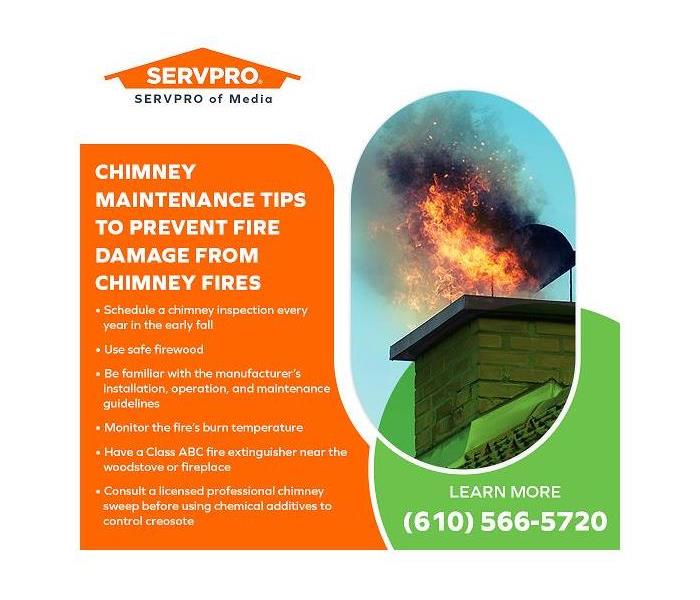Helping Newton Square, PA, Homeowners Avoid Fire Damage by Practicing Proper Chimney Maintenance
10/11/2022 (Permalink)
Blog Summary: SERVPRO of Media highlights chimney maintenance tips to prevent fire damage from chimney fires.
A chimney fire is a traumatic fire damage event for the occupants of a home. Some chimney fires occur without the residents even being aware of the danger. A chimney fire has the potential to cause extensive property damage as well as personal injury. The proper use and maintenance of fireplaces and wood stoves can prevent chimney fires and save lives. Homeowners can practice the chimney maintenance tips below for a warm, safe home during the winter.
Tip: Schedule a chimney inspection every year in the early fall.
Both the National Fire Prevention Association and the Chimney Safety Institute of America recommend chimneys be inspected and cleaned on an annual basis. An inspection in the early fall will discover any animal or insect nests built the previous spring and summer. The homeowner can light the first fire of the year knowing the chimney is clean and structurally sound.
When hiring a chimney professional, look for these key features:
- Sweeps the flue to remove loose soot and creosote (Animal and insect nests and other debris should be removed from the smoke chamber, smoke shelf, and firebox.)
- Presents a written, well-documented report on the condition of the chimney (This report may include images and video of the chimney.)
- Recommends repairs and offers advice on how to better care for the chimney
- Guarantees to clean up any mess from the inspection and maintenance process
Tip: Use safe firewood.
Dense hardwoods such as oak, maple, and elm are best for the fireplace or wood stove. The hardwoods cure best when split, stacked, and allowed to dry out in a well-ventilated area for six months to a year. The moisture content should be 20% or less. Cracks on the ends of the split logs indicate sufficient curing may have taken place. A moisture meter can verify the moisture content of the wood.
Evergreens dry out more quickly, but the creosote content is much higher. The temptation is to burn cardboard and Christmas wrapping paper in the fireplace or wood stove. Paper fires burn very hotly, increasing the risk of igniting creosote in the chimney. Do not burn wood that has been treated or painted since the wood releases dangerous toxins during combustion.
Tip: Be familiar with the manufacturer’s installation, operation, and maintenance guidelines.
Be able to manage the combustion air intake for the fireplace or wood stove. Fire requires oxygen. Make sure the appliance has adequate airflow for the fire to burn efficiently. Creosote will build up if the fire is smoky and smoldering. If the appliance has a glass front, watch for smoke stains on the glass, which may indicate the fire is not burning hot enough.
The manufacturer’s established maximum burn times, an indication of the fire’s temperature, may vary. The type and condition of the wood, the type of chimney, the season of the year, the location of the appliance, and the stove’s (or fireplace’s) interaction with other heating appliances in the home can and do influence burn times.
Tip: Monitor the fire’s burn temperature.
Two options are a magnetic thermometer and a probe thermometer. A magnet thermometer attaches to the stove surface or a connector pipe. The optimum surface temperature is 300-500 degrees Fahrenheit.
The probe thermometer provides a more accurate temperature measurement because it registers the core temperature of the flue gases rising from the fire. The optimal temperature range is 600-1000 degrees Fahrenheit. By keeping the fire burning at or within optimal temperature ranges, creosote accumulation can be prevented or minimized.
Tip: Have a Class ABC fire extinguisher near the woodstove or fireplace.
Make sure everyone in the home who is physically capable understands how the device works and how to use it in the event of a fireplace fire. Special chimney fire extinguishers are available to prevent a chimney flare, but these extinguishers function best in an airtight system. Never use accelerants in a woodstove or fireplace.
Tip: Consult a licensed professional chimney sweep before using chemical additives to control creosote.
Be aware that the thickness and extent of the creosote may require multiple applications to achieve satisfactory results.
A fire damage disaster often involves structural damage from the flames. Smoke and soot create a toxic environment for humans and pets. Water damage from the fire hose used to extinguish the flames may be more extensive and costly to remediate than the actual fire damage. The professionals at SERVPRO® of Media are available 24/7, 365 days a year, to provide a rapid response and quick cleanup and restoration when a complex fire damage disaster occurs. Delay allows the situation to grow in scope and severity, adding unnecessary expense and hassle to the project. The best time to reach out to a fire damage cleanup and restoration company is before a fire. Waiting until after a disaster has occurred can be a disaster! Call today while the home is not in flames, the roof is not leaking, the ceilings are not sagging, the walls are not warping, the floors are not buckling, the sewage is not backed up, and mold has not made a meal of anything organic in the home.
Contact SERVPRO of Media to learn more about fire damage restoration in Newtown Square, PA. The office can be reached by phone at (610) 566-5720 or by email at office@SERVPROmedia.com.






 24/7 Emergency Service
24/7 Emergency Service
